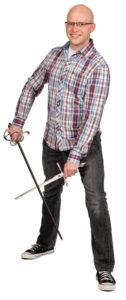In Class: Sword Player
 Theater professor and fight director Zev Steinberg. (Image by L. Brian Stauffer)
Theater professor and fight director Zev Steinberg. (Image by L. Brian Stauffer) I teach stage combat to senior acting students. We work with a single sword, which is the classic Hollywood, swashbuckling saber. Like the one in Errol Flynn films—The Mark of Zorro—and made famous again in Pirates of the Caribbean. Not a great deal of martial arts logic to it, but it is very flashy.
We also study unarmed, hand-to-hand combat: how to punch each other without actually punching each other; how to slap each other; how to throw each other to the ground; how to roll; how to kick. Pulling hair, choking, all that stuff. This is what my students do for college credit.
Actors train in this so they can do live stage shows that involve violence. Shakespeare plays often culminate in sword fights—especially the tragedies—and the actors must be able to make the action look believably dangerous and repeat it eight times a week without actually hurting each other.
Stage swords don’t have any sharp edges or sharp points. But they are designed to strike each other and to be dropped, to be used incorrectly over and over and over again and not break. They are steel—they are very real weapons—they are just completely dull. But at the end of the day, the prop is not keeping people safe. It’s the person who’s using it.
We choreograph fights in such a way that if an injury is going to happen, it’s going to be minimal. Like, when I’m cutting with the sword, I’m aiming way down, by your bicep. If I do accidentally hit you, it’s on a soft, meaty bit. I’m not hitting you in the shoulder bone. I’m not hitting you in the face. We never attack the face. Ever. Because that’s the money-maker. Protect the 8 x 10, as I would put it.
With firearms, you have a whole layer of additional safety concerns. If we’re doing a show with a firearm, there’s going to be a gun wrangler, so there’s always somebody watching the guns.
And firing blanks onstage—if you put your hand over the vent and fire the gun, you’re going to blow a hole through your hand. In the past 30 years, there have been five deaths from theatrical firearms, either from people accidentally putting real rounds into a firearm or from people firing it too close.
I’ve put together an online course called “Violence as a Narrative Tool.” We look at violence design in films and onstage—and how we tell stories using violence. For example, the moment in a story when violence is necessary. That’s when the stakes are as high as they can be: life or death.
My best advice to students? Breathe. And never lose sight of the fact that you have a sword in your hand.
Edited and condensed from an interview conducted on March 30, 2017.


